COMPLETE HISTORY OF THE RUSSIAN MIG AIRCRAFT - Page 1
37 PHOTOS of MIGS
MIG-1 THROUGH MIG-35
INTRODUCTION
Mikoyan-I-Gurevich design bureau is a Russian military aircraft design bureau primarily for fighter aircraft. It was formerly a Soviet design bureau founded by Artem Mikoyan and Mikhail Gurevich, known as “MIG.” The Russian government is planning to merge Mikoyan and Gurevich with Ilyushin, Irkut, Sukhoi, Tupolev, and Yakovlev as a new company named “United Aircraft Corporation.” The MIG has been used by the Chinese, North Korea, and North Vietnam in aerial confrontation with American and Allied forces.
The first 100 aircraft produced in 1940 were designated starting with MIG-1. Improved aircraft were designated MIG-3, and so on. The MIG-3 is a variant of the MIG-1. The service designation MIG-5 was only represented by a few experimental aircraft and was cancelled in 1942.
From the technical description of the MIG starting with the MIG-1 it is evident the MIG was continually upgraded and modified in an effort to produce a better aircraft. Most of the first MIGs had major problems but by producing many variants they were overcome. They finally succeeded with the MIG-15 which was considered their first aircraft having great performance.
It cannot be disputed that the MIG-15 changed the Korean war abruptly. First of all the thousands of Chinese troops that stormed across the Yalu pushed our forces back, and just about wiped out our Marines at the Chosin Reservoir. With the ground war going badly the swarms of MIG-15s crossed the border by the hundreds, changing the final picture. The MIG-15 with its three cannons, 670mph speed, exceptional altitude capability, plus being flown by Russia’s finest delivered the final blow to our aging B-29 fleet. The MIG-15 with their cannons became the B-29s worst nightmare.
This report was gathered in part from Russian sources and publications. It proved to show many confusing designations, and descriptions as names were added or dropped on numerous models. One example is the many designations of the Mig-29 and the Mig-33. This report has undoubtedly many discrepancies however much effort was made to try to identify these aircraft.
This website covers the complete MIG production from MIG-1 THROUGH MIG-35
 |
|---|
| MIG-1 Built in 1941, first of a distinguished line of aircraft, the MIG-1 was a small, very good high altitude interceptor, but it’s career was cut short because the USSR concentrated on low and medium altitude fighters. Many variants were developed from the MIG-1. |
 |
|---|
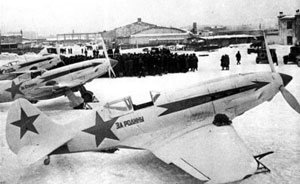 |
| MIG-3 1941. The MIG-3, a development of the MIG-1, received many modifications in the next two years. 3422 MIG-1s and MIG-3s were built. In WW-II, many MIG pilots rammed German bombers after running out of ammo. Pilots were ordered to “stop the bombers by any means.” The MIG-1 and MIG-3 were also used for ground attack, however they were better high altitude interceptors with limitations in low altitude performance. Speed was reported at 398 mph. The 1 and 3 carried machine guns. The MIG-3 was actually a highly modified MIG-1. Spin and stall conditions were dangerous. Three MIG-3s intercepted a German recon. Plane, and all three crashed from uncontrollable spins. Many variants were used, one with a six bladed prop. A restored MIG-3 actually flew a aerobatic routine at the 2007 Airshow. |
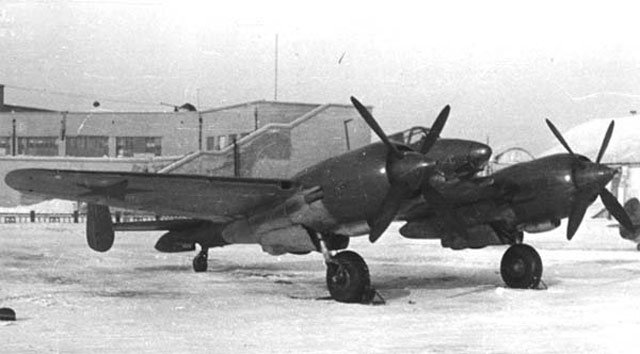 |
|---|
| MIG-5 Probably the most incorrectly reported Russian aircraft. The name“MIG-5” was reserved, however it was actually a twin engine aircraft which never used the MIG-5 designation. This plane was given the designation MIG-DIS-T. Only two were built and the entire MIG-5 production was quickly cancelled. The MIG was having a rough time getting started. The inconsistent modifications of the MIG-5, variants of the MIG-1, then the confusion of introducing the twin engine “escort fighter,” led to the cancellation of the whole program. As far as we know only two MIG-5 variant of the MIG-3 were built. They were never used. |
| NO AIRCRAFT PHOTO FOR MIG-7 |
|---|
| MIG-7 The MIG-7 was actually a very poor attempt to modify the MIG-3 with a re-engine using the Mikulin AM-37. One MIG-3 was built to evaluate the proposed variant. It had very poor performance and was immediately cancelled. The AM-37 engine went out of production and the entire project stalled. It then became obvious the idea of a piston engined fighter was over, and no production was ever ordered. The final attempt to salvage the MIG-7 was to install a radial engine, even tested the MIG-3 with the Pratt &Whitney R-2800-63. |
 |
|---|
| MIG-8 The Russians produced many experimental aircraft such as this MIG-8 which is seemingly misnamed. It was an aerodynamic research vehicle. A small aircraft, it had a pusher engine, high set swept wings, forward canards, made of wood and fabric. It was cancelled in 1945. Reported speed was 127 mph. |
 |
|---|
| MIG-9 FARGO Built in 1947, it was a first generation turbojet fighter and attack aircraft developed immediately after the war. 598 were built, using 23mm and 37mm cannons. The MIG-9 suffered from an unreliable engine and had control problems. Designers then started experimenting with swept wings and redesigned tail, leading to the highly successful MIG-15. |
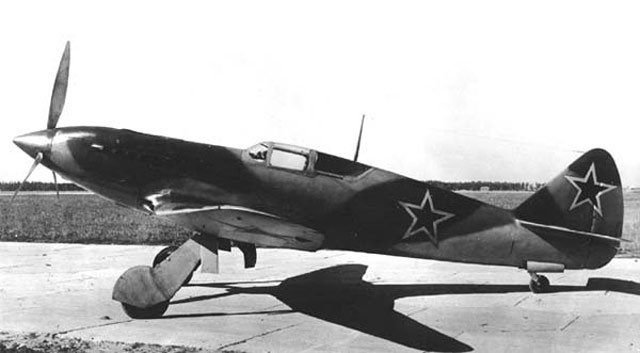 |
|---|
| MIG-11 On March 10, 1942, the Russian Air Force approved the preliminary project of the MIG-11 fighter, powered by an AM-37 engine. They had various difficulties in obtaining the proper engine so an AM-38F was installed in aircraft # 1 permitting the first test stage and to get preliminary results. The aircraft was meant for active air battles at all altitudes. Armament consisted of two synchronous 20mm cannon, each with 150 shells. First aircraft prototype was built in 1942, and made its first flight on Dec. 26, 1942. Test pilot A.I. Zhukov. The aircraft was damaged on landing. Aircraft # 2 was damaged in a forced landing. Final installation of the AM-39 engine improved performance, but engine failure and inability to acquire a new AM-39 put an end to the tests. The aircraft was transformed eventually into the first I-225 prototype. The problems continued. |
 |
|---|
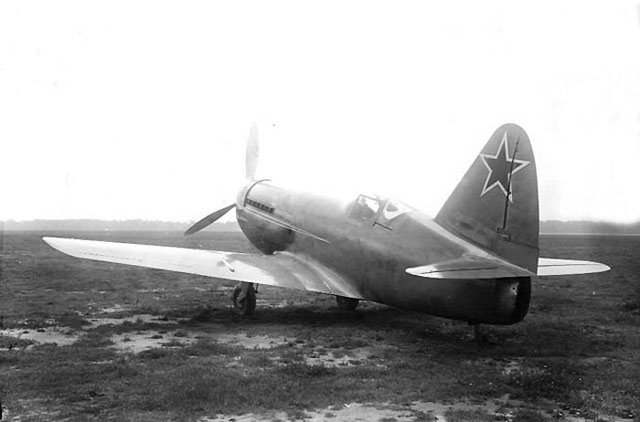 |
| MIG-13 First flight of this aircraft was made on March 3, 1945. The first two crashed, the same as with the MIG-11. The MIG-11 had the unusual disadvantage of being a “mixed-power” which used, or tried to use an engine “accelerator” which was a complex called the VRDK. This engine used a reaction engine compressor which fed compressed air via a water radiator to a mixing chamber under pressure with the mixture being ignited in a walled combustion chamber and then ejected providing thrust for 10 minutes and boosting speed. It is no wonder this complex aircraft met with a predictable crashes. The reported speed of this controversial aircraft was 513 mph which is highly suspicious to say the least. MIG has a history of unusual design but this one is probably number one. A total of 16 pre-series AC were delivered to the Navy as MIG-13s. This aircraft once again was very questionable as was the actual design, and was retired from the Navy in 1948. Another designer’s disaster bites the dust. |
 |
|---|
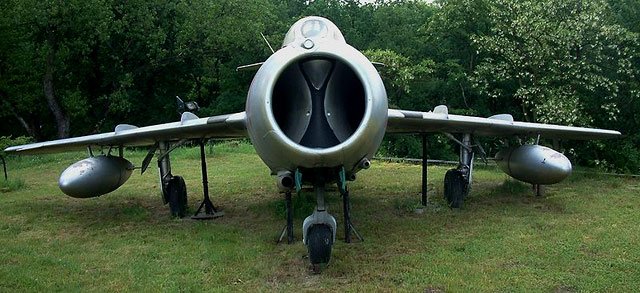 |
| MIG-15 FAGOT Single engine interceptor/fighter of Korean War fame, armed with two 23mm and one 37mm cannons was an unpleasant surprise to American forces. It had serious shortcomings in handling but it’s performance was superior to that of any other fighter. The engine that pushed this plane to amazing speed and altitude was a license built copy of the Rolls-Royce “Nene.” The MIG-15 is the most built fighter with over 18,000 produced. Over 20 countries used the trainers, some of which are still in service. After all the years of frustration with engine failures, design and performance problems the Russians were finally on their way to producing outstanding fighter aircraft of unquestionable capability. |
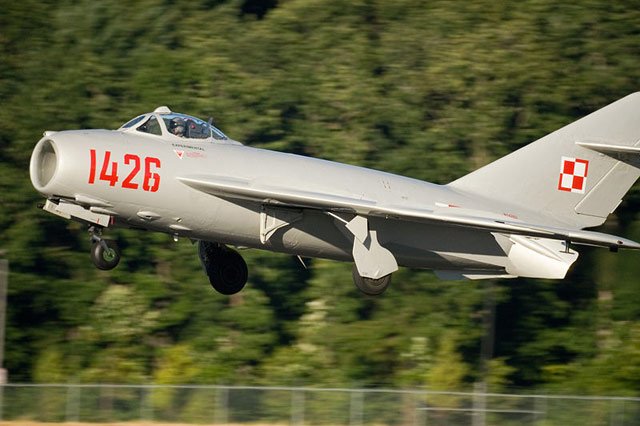 |
|---|
| MIG-17 FRESCO The MIG-17 was first seen in 1949 on Soviet Aviation Day. It entered service in 1954. The MIG-17 design was based as an upgrade to their highly successful MIG-15, had higher speed and greater maneuverability at higher altitude than the MIG-15. Top speed reported at 711 at 10,000 ft. It used three cannons. This aircraft was used by at least 25 countries. It was used successfully in Vietnam because of it’s agility and powerful firepower. |